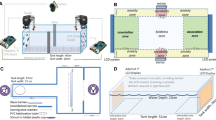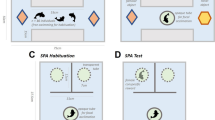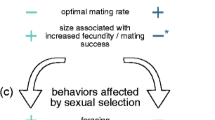Abstract
Spatial learning is an important cognitive function found across a multitude of species. Natural selection can enhance specific cognitive abilities depending on species ecology but, under certain conditions, spatial learning is also known to vary between sexes according to reproductive status. Despite abundant studies on spatial learning across animal taxa, those focusing on sexually dimorphic spatial learning have been largely limited to rodents. Here, we found that spatial cognition varies between the sexes in an intertidal goby, and this difference fluctuates across seasons. Males and females demonstrated similar cognitive abilities when solving a simple maze during all seasons except spring, when males were significantly less successful than females. Spring marks the beginning of the breeding season for this species, when females move between nests to choose a suitable mate, while males guard their nest and forego foraging excursions. We suggest that the reduction in male cognitive ability reduces metabolic costs at a time of reduced need. This study presents the first evidence for sexually dimorphic spatial learning in fish driven by differences in reproductive behaviour as dictated by the mating system.




Similar content being viewed by others

References
Aronson LR (1951) Orientation and jumping behaviour in the gobiid fish Bathygobius soporator. Am Mus Novit 1286:1–22
Aronson LR (1971) Further studies on orientation and jumping behavior in the gobiid fish, Bathygobius soporator. Ann N Y Acad Sci 188(1):378–392
Astié AA, Kacelnik A, Reboreda JC (1998) Sexual differences in memory in shiny cowbirds. Anim Cogn 1(2):77–82
Broglio C, Rodriguez F, Salas C (2003) Spatial cognition and its neural basis in teleost fishes. Fish Fish 4:247–255
Brown C (2003) Habitat–predator association and avoidance in rainbowfish (Melanotaenia spp.). Ecol Freshw Fish 12:118–126
Brown C, Braithwaite VA (2004) Size matters: a test of boldness in eight populations of the poeciliid Brachyraphis episcopi. Anim Behav 68:1325–1329
Carazo P, Noble DW, Chandrasoma D, Whiting MJ (2014) Sex and boldness explain individual differences in spatial learning in a lizard. Proc R Soc B 281(1782):20133275
Carneiro LA, Andrade RP, Oliveira RF, Kotrschal K (2001) Sex differences in home range and dorso-lateral telencephalon in the Azorean rock-pool blenny. Soc. Neurosci, Abs, p 27
Costa SS, Andrade R, Carneiro LA, Gonçalves EJ, Kotrschal K, Oliveira RF (2011) Sex differences in the dorsolateral telencephalon correlate with home range size in Blenniid fish. Brain Behav Evol 77:55–64
Cummings ME (2018) Sexual conflict and sexually dimorphic cognition—reviewing their relationship in poeciliid fishes. Behav Ecol Sociobiol 72(4):73
Fabre N, García-Galea E, Vinyoles D (2014) Spatial learning based on visual landmarks in the freshwater blenny Salaria fluviatilis (Asso, 1801). Learn Motiv 48:47–54
Floresco SB (2014) Spatial learning in animals. In: Encyclopedia of psychopharmacology. Springer, Berlin, pp 1620–1623
Galea LAM, Kavaliers M, Ossenkopp KP, Innes D, Hargreaves EL (1994) Sexually dimorphic spatial learning varies seasonally in two populations of deer mice. Brain Res 635(1–2):18–26
Galea LA, Kavaliers MARTIN, Ossenkopp KP (1996) Sexually dimorphic spatial learning in meadow voles Microtus pennsylvanicus and deer mice Peromyscus maniculatus. J Exp Biol 199(1):195–200
Garber PA (1989) Role of spatial memory in primate foraging patterns: Saguinus mystax and Saguinus fuscicollis. Am J Primatol 19(4):203–216
Gaulin SJ, Fitzgerald RW (1986) Sex differences in spatial ability: an evolutionary hypothesis and test. Am Nat 127(1):74–88
Gaulin SJ, Fitzgerald RW (1989) Sexual selection for spatial-learning ability. Anim Behav 37:322–331
Gaulin SJC (1995) Does evolutionary theory predict sex differences in the brain? In: Gazzaniga MS (ed) The cognitive neurosciences. MIT, Cambridge, pp 1211–1224
Gibson RN (1967) The agonistic behaviour of juvenile Blennius pholis L. (Teleostei). Behaviour 30(2):192–217
Gibson RN (1999) Movement and homing in intertidal fishes. In: Horn MH, Martina KLM, Chotkowski MA (eds) Intertidal fishes: life in two worlds. Academic Press, San Diego, pp 97–125
Giraldeau LA (1997) The ecology of information use. Behav Ecol Evol Approach 4:42–68
González-Gómez PL, Madrid-Lopez N, Salazar JE, Suárez R, Razeto-Barry P, Mpodozis J, Bozinovic F, Vásquez RA (2014) Cognitive ecology in hummingbirds: the role of sexual dimorphism and its anatomical correlates on memory. PLoS ONE 9(3):e90165
Gray JA, Buffery AW (1971) Sex differences in emotional and cognitive behaviour in mammals including man: Adaptive and neural bases. Acta Physiol (Oxf) 35(2):89–111
Griffiths SP (2003) Homing behaviour of intertidal rockpool fishes in south-eastern New South Wales, Australia. Aust J Zool 51(4):387–398
Halpern DF (1991) Sex differences in cognitive ability, 2nd edn. Erlbaum, Hillsdale
Healy S (ed) (1998) Spatial representation in animals. Oxford University Press, New York
Healy SD, Jones CM (2002) Animal learning and memory: and integration of cognition and ecology. Zoology 105:321–327
Hernaman V, Munday PL (2007) Evolution of mating systems in coral reef gobies and constraints on mating system plasticity. Coral Reefs 26(3):585–595
Jacobs LF (1996) The economy of winter: phenotypic plasticity in behavior and brain structure. Biol Bull 191(1):92–100
Jones CM, Braithwaite VA, Healy SD (2003) The evolution of sex differences in spatial ability. Behav Neurosci 117(3):403
Jorge PE, Almada F, Gonçalves AR, Duarte-Coelho P, Almada VC (2012) Homing in rocky intertidal fish. Are Lipophrys pholis L. able to perform true navigation? Anim Cognit 15(6):1173–1181
Jozet-Alves C, Modéran J, Dickel L (2008) Sex differences in spatial cognition in an invertebrate: the cuttlefish. Proc R Soc Lond B Biol Sci 275(1646):2049–2054
Kavaliers M, Ossenkopp KP, Prato FS, Innes DGL, Galea LAM, Kinsella DM, Perrot-Sinal TS (1996) Spatial learning in deer mice: sex differences and the effects of endogenous opioids and 60 Hz magnetic fields. J Comp Physiol A 179(5):715–724
Kavaliers M, Ossenkopp KP, Galea LA, Kolb B (1998) Sex differences in spatial learning and prefrontal and parietal cortical dendritic morphology in the meadow vole Microtus pennsylvanicus. Brain Res 810(1–2):41–47
Kimura D (1999) Sex and cognition. MIT, Cambridge
Kong YH, Chen IS (2013) Reproductive biology of intertidal frillfin goby, Bathygobius fuscus in Keelung, Taiwan. J Mar Sci Technol 21:213–215
Krebs JR (1990) Food-storing birds: adaptive specialization in brain and behaviour? Philos Trans R Soc Lond B 329(1253):153–160
Lacreuse A, Herndon JG, Killiany RJ, Rosene DL, Moss MB (1999) Spatial cognition in rhesus monkeys: male superiority declines with age. Horm Behav 36(1):70–76
Lucon-Xiccato T, Bisazza A (2017) Sex differences in spatial abilities and cognitive flexibility in the guppy. Anim Behav 123:53–60
Markel RW (1994) An adaptive value of spatial learning and memory in the blackeye goby Coryphopterus nicholsi. Anim Behav 47(6):1462–1464
Mazzoldi C, Petersen CW, Rasotto MB (2005) The influence of mating system on seminal vesicle variability among gobies (Teleostei, Gobiidae). J Zool Syst Evol Res 43(4):307–314
Noble DW, Carazo P, Whiting MJ (2012) Learning outdoors: male lizards show flexible spatial learning under semi-natural conditions. Biol Let 8(6):946–948
Odling-Smee L, Braithwaite VA (2003) The role of learning in fish orientation. Fish Fish 4(3):235–246
Odling-Smee L, Simpson SD, Braithwaite VA (2006) The role of learning in fish orientation. In: Brown C, Laland KN, Krause J (eds) Fish cognition and behaviour. Blackwell, Cambridge, pp 119–138
Odling-Smee L, Simpson SD, Braithwaite VA (2011) The role of learning in fish orientation. In: Brown C, Laland K, Krause J (eds) Fish cognition and behavior. Wiley-Blackwell, Chichester, pp 166–185
Roy T, Bhat A (2017) Divergences in learning and memory among wild zebrafish: do sex and body size play a role. Learn Behav 46:124–133
Schaafsma SM, Groothuis TG (2011) Sex-specific effects of postnatal testosterone on lateralization in cichlid fish. Anim Behav 81(1):283–288
Sherry DF, Hampson E (1997) Evolution and the hormonal control of sexually-dimorphic spatial abilities in humans. Trends Cogn Sci 1(2):50–56
Silverman I, Eals M (1992) Sex differences in spatial abilities: evolutionary theory and data. In: Portions of this paper were presented at the meetings of the International Society for Human Ethology in Binghamton, NY, Jun 1990, the Human Behavior and Evolution Society in Los Angeles, CA, Aug 1990, and the European Sociobiological Society in Prague, Czechoslovakia, Aug 1991. Oxford University Press, Oxford
Smith GT, Brenowitz EA, Wingfield JC (1997) Seasonal changes in the size of the avian song control nucleus HVC defined by multiple histological markers. J Comp Neurol 381:253–261
Sovrano VA, Bisazza A, Vallortigara G (2003) Modularity as a fish (Xenotoca eiseni) views it: conjoining geometric and nongeometric information for spatial reorientation. J Exp Psychol Anim Behav Process 29(3):199–210
Spritzer MD, Daviau ED, Coneeny MK, Engelman SM, Prince WT, Rodriguez-Wisdom KN (2011) Effects of testosterone on spatial learning and memory in adult male rats. Horm Behav 59(4):484–496
Taru M, Kanda T, Sunobe T (2002) Alternative mating tactics of the gobiid fish Bathygobius fuscus. J Ethol 20:9–12
Tavolga WN (1954) Reproductive behaviour in the gobiid fish Bathygobius sporator. Bull Am Mus Nat Hist 104:427–460
Thacker CE (2009) Phylogeny of Gobioidei and placement within Acanthomorpha, with a new classification and investigation of diversification and character evolution. Copeia 2009:93–104
Thia JA, Riginos C, Liggins L, Figueira WF, McGuigan K (2018) Larval traits show temporally consistent constraints, but are decoupled from postsettlement juvenile growth, in an intertidal fish. J Anim Ecol 87(5):1353–1363
Tramontin AD, Smith GT, Breuner CW, Brenowitz EA (1998) Seasonal plasticity and sexual dimorphism in the avian song control system: stereological measurement of neuron density and number. J Comp Neurol 396:186–192
Tramontin AD, Brenowitz EA (2000) Seasonal plasticity in the adult brain. Trends Neurosci 23:251–258
Vinyoles D, De Sostoa A (2007) Life-history traits of the endangered river blenny Salaria fluviatilis (Asso) and their implications for conservation. J Fish Biol 70(4):1088–1108
White GE, Brown C (2013) Site fidelity and homing behaviour in intertidal fishes. Mar Biol 160(6):1365–1372
White GE, Brown C (2014a) A comparison of spatial learning and memory capabilities in intertidal gobies. Behav Ecol Sociobiol 68(9):1393–1401
White GE, Brown C (2014b) Cue choice and spatial learning ability are affected by habitat complexity in intertidal gobies. Behav Ecol 26(1):178–184
Wickler W (1957) Vergleichende Verhaltensstudien an Grundfischen I. Beiträge zur Biologie, besonders zur Ethologie von Blennius fluviatilis Asso im Vergleich zu einigen anderen Bodenfischen. Ethology 14(4):393–428
Yaskin VA (1984) Seasonal changes in brain morphology in small mammals. In: Advances in the biology of shrews. Carnegie Museum of Natural History Special Publication
Acknowledgements
This research was funded by the Department of Biological Sciences at Macquarie University, and P. Carbia as supported by an MQ10 PhD Scholarship. The authors wish to thank the SWF technician of Macquarie University, Josh Aldridge, for assistance in animal husbandry.
Author information
Authors and Affiliations
Corresponding author
Ethics declarations
Conflicts of interest
The authors declare no conflicts of interest.
Ethical approval
Gobies were caught in compliance with NSW Fisheries (Permit No. P08/0010-3.0). Husbandry and experimental conditions were approved by the Macquarie University Ethics Committee (ARA 2014/003). All individuals were kept in the Sea Water Facility of Macquarie University for the full duration of the experiment to prevent re-capture of individuals. Upon conclusion of research, all gobies were released at the site of capture.
Additional information
Publisher's Note
Springer Nature remains neutral with regard to jurisdictional claims in published maps and institutional affiliations.
Electronic supplementary material
Below is the link to the electronic supplementary material.
Rights and permissions
About this article
Cite this article
Carbia, P.S., Brown, C. Seasonal variation of sexually dimorphic spatial learning implicates mating system in the intertidal Cocos Frillgoby (Bathygobius cocosensis). Anim Cogn 23, 621–628 (2020). https://doi.org/10.1007/s10071-020-01366-3
Received:
Revised:
Accepted:
Published:
Issue Date:
DOI: https://doi.org/10.1007/s10071-020-01366-3



